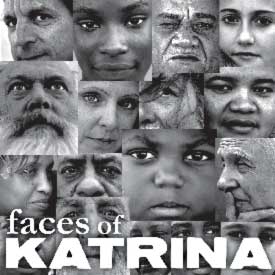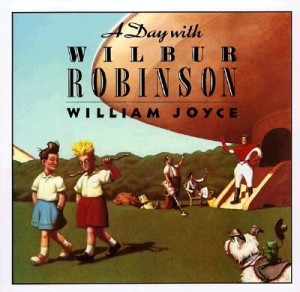Where to begin…
… well I guess we’ll start at the beginning.
Brief Bio-
- William Joyce was born December 11, 1957.
- Is married, has two children, and lives in Shreveport, Louisiana.
- Attended art school at Southern Methodist University, but after his professor tried to change they way he painted, he dropped out.
- Went to film school, where he learned animation.
- Moved to New York and had his first book, Tammy and the Gigantic Fish published in 1983.
William Joyce is by far an extremely talented artist. His gift has allowed him to cross various artistic mediums. He is a children’s book writer and illustrator. He has worked on animated children’s movies and series. He also has helped produce, design, and direct exhibitions. Joyce definitely has an eye for visual artistry.
Many of his works demonstrate his genius, however in “The Faces of Katrina”, an exhibit that recounts the stories of many of the survivors of hurricane Katrina —which was spear-headed and put together by Joyce– his creative ability of story telling with sequential images really shines through.

Faces of KATRINA
William Joyce uses pictures –images— that move audiences to experience the same apprehension and questions these survivors feel. What does the future hold for them? How will they ever recover?
He becomes a narrative writer as he places natural images in such a way, that the story of the Katrina survivors unfolds itself before our eyes. We don’t need to see actual representation of the destruction, to feel the pain of these people. The images transcend any conventions, for pain is real to anyone, no matter what nationality, gender, or culture they belong to. The eyes and facial expressions a person manifests when losing a home or loved one, is universal.
However, when people think of William Joyce’s, it’s his children’s books that come to mind. Let’s take a look at a few of them.
*George Shrinks

George Shrinks
Originally published in 1987. Was turned into a children’s animated television show on PBS airing from September 30, 2000 until mid- 2004.
Joyce noticed that things are usually made for a world of grown-ups; a.k.a giants to children. So he decided to “paint” a world that would depict how children feel. Readers experience the sensations of feeling short through the way the scenes are composed. Not only is George very small and the items around him are gigantic, but his interaction with his toys, his pets, and even his brother, makes his smallness more real.
The pictures themselves don’t need the words to help the reader along. The fist image clearly places George in a secure environment, only to wake up shocked at being small. Once can infer that he is brushing his teeth without having to read “brush your teeth” (6) or that he is in a tub, perhaps destined to take a bath since he has no cloths on without having to read “and take a bath” (7). Perhaps the picture on page 13 is slightly more difficult to interpret as all we see is screaming children and a scared cat, dropping a poor mouse. We don’t immediately think that he is supposed to be doing the opposite “and play quietly.” Here is definitely an instance where words help the reader have a clearer meaning of Joyce’s actual intentions. This happens again on page 17 when all we see is George riding an airplane. If the words were not there, we would perhaps, think that George is just having a joy ride, when his parents simply told him to have “some fresh air.” However, it would seem that Joyce doesn’t mind if the reader just goes along for a joy ride with George, for he completely omits any words on pages 18 and 19.Furthermore, Joyce helps the reader experience George’s exciting adventure with the cat, as he just lets the pictures tell the tale of the climatic encounter between George and the cat.
*A Day with Wilbur Robinson

A Day with Wilbur Robinson
Originally published in 1990.It was adapted by Walt Disney Animation Studios and made into a CGI children’s film released in March, 2007. In this semi-autobiographical children’s book, Joyce captured “normal” everyday occurrences in his household.
At first there is no clear indication as to what era Joyce is trying to capture. As though Joyce is trying to steer clear from type casting a certain epoch. However, after carefully examining Mrs. Robinson and Wilbur’s two sister’s hair, it appears that Joyce is harking to the Golden Era of America; the late 1940’s. He is not afraid to blend or mix and match futuristic images i.e. robots and flying saucers, with historic, more customary ones i.e. mummies and time clocks. He juxtaposes innovative with the traditional.
The pictures in A Day with Wilbur Robinson are not as straight forward as the ones in George Shrinks. This is one story where the illustrations benefit from the words. The images themselves depict strange occurrences i.e. an octopus hiding behind a door or a man calmly walking with two tigers. We would have no indication that the strange events were just a typical, in fact “dull” day, at the Robinson’s house. People would have multiple versions of the book, if the pictures didn’t have the words to help form the story.
*Dinosaur Bob and His Adventures with the Family Lazardo

Dinosaur Bob and His Adventures with the Family Lazardo
Was first published in 1989.It’s also another “representation” of Joyce’s life when he was a kid.
In the book, Joyce captures the look and feel of 1929 America. As soon as the book is opened, we are greeted with a green and white, turn of the century style map. It creates a nostalgic allure to the day when expeditions to Africa were mounted and things were still being discovered. He uses lots of blue and green, which are soothing colors, and created a comfortable feeling. Additionally, by having a dinosaur (a symbol representing adventure and excitement) play baseball, (a game that symbolizes patriotism) not only does he evoke emotions of nationalism, but he blends adventure with an all American game.
Dinosaur Bob is a picture-book that would probably fair well with or without the words. By omitting the words, we are still able to infer that the family Lazardo found a dinosaur, played with it, sailed across a river, then across the ocean, traveled on land to their home, etc. etc. This all can be gathered by just looking at the pictures. The words simply helped give depth to the story. That the family Lazardo adopted the dinosaur as part of their family and called him Bob because he looked like Mrs. Lazardo’s uncle. Furthermore, that when Bob and the Lazardo’s sailed across to America, every night the children would take him a snack and sing him a special song. All the bonding experiences between Bob and the Lazardo’s were augmented with the addition of words to the pictures. In essence, the book contains a perfect harmony between the pictures and the words.
*Santa Calls

Santa Calls
Originally published in 1993.
As with many of his works, Santa Calls captures a spirit of nostalgia. Furthermore, there seems to be a Wizard of Oz and Peter Pan influence. The Dark Elves and the Dark Queen brought back memories of the Wicket Witch of the West and her monkey army. The children’s trip to the North Pole on the flying canoe resembled the trip Wendy and her brothers took to Neverland on a ship across the sky. By stirring memories of stories already endeared and well known, Joyce expertly creates a stronger bond with Santa Calls.
Like A Day with Wilbur Robinson, the illustrations in Santa Calls need the words to help guide readers on the right path. The pictures by themselves don’t really convey the actual story that is taking place. One only views children, gathering together perhaps to have fun or create some sort of mischief. A little into the book, one finally realizes that the story has something to do with Santa Clause. Then, all of a sudden we see the girl taken and then a great big gathering. The crowd for some strange reason gets violent and throws things. Suddenly, we see the children sleeping in bed while Santa Clause watches over them. If it wasn’t for the words, we would not have figured out that that one of the boys and the girl were siblings that didn’t get along and that the girl had written to Santa, wishing as a Christmas gift for her brother to think of her as a friend. We would also not have figured out that there was a war between the Dark Elves led by the Dark Queen and Santa Clause. The pictures narrative definitely benefited by the words.
There is never a dull moment in either reading or watching William Joyce’s creative works. He is always drawing the imagination of children and adults with his artistic narrative style. Nothing gets past his creative talent and as he said so himself, he likes to stir things up.
Links:
William Joyce Presents http://www.williamjoyce.com/
Reading Rockets http://www.readingrockets.org/books/interviews/joyce
Aimesworth Amusements http://www.aimesworth.com/main.html
Leave a comment